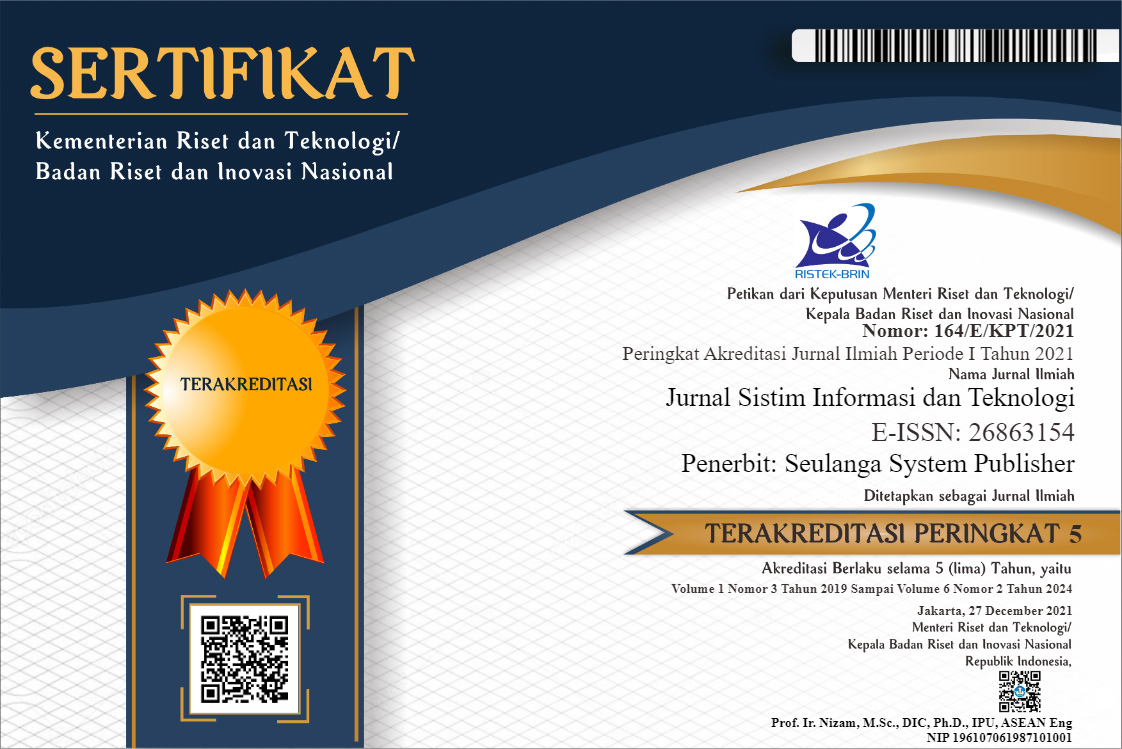Tingkat Formulasi Model Soal dalam Permutasi Acak Menggunakan Algoritma Fisher Yates
DOI:
https://doi.org/10.37034/jsisfotek.v3i4.76Keywords:
Formulation Level, Problem Model, Random Permutations, Fisher Yates', AlgorithmAbstract
The problem model in random permutations results in random randomization of the most commonly used questions in exam practice in education ranging from elementary school to college level and even some agencies that utilize exams to test one's abilities. This Problem Model can produce a high random percentage with more complex processes compared to analogues. Conduct Model Formulations on infinite questions so that they can be easily utilized without complicated calculations. The problems processed in this study are from 50 questions, and 12 students are sourced from the Information System Study Program of STMIK Logika, at Medan Indonesia state. Based on the collection of the question by the head of the study program in charge of the STMIK. Furthermore, the problem is saved into the database. The next stage is to randomize the question based on the number of students taking the exam. The problem has been randomized into a model formulation of the question in a random permutation of the question at the time of the Test practice. The result of the test on this question is a matter of courses. Randomized questions can form a problem model in random permutations based on many questions, the number of questions. All questions are made by lecturers who teach courses and help the study program in the teaching and learning process with the formulation of the problem model.
References
Xin, Y. P. (2012). Conceptual model-based problem solving: Teach students with learning difficulties to solve math problems. Brill Sense.
Yendra, R., Marifni, L. & Suryani, I. (20200 Klasifikasi Data Mining Untuk Seleksi Penerimaan Calon Pegawai Negeri Sipil Tahun 2017 Menggunakan Metode Naive Bayes. J. Sains Mat. dan Stat., 6(1). doi: http://dx.doi.org/10.24014/jsms.v6i1.9254.
Indonesia, U. U. R. (2003). Sistem pendidikan nasional. Jakarta: Direktorat Pendidikan Menengah Umum. 2003.
Susilo, J. & Yenni, H. (2014). Perancangan Sistem Ujian Seleksi Penerimaan Mahasiswa Baru Dengan Menggunakan Algoritma Fisher-Yates Shuffle pada STMIK-AMIK RIAU. Sains dan Teknol. Inf., 3(2), 27–32.
Hasan, M. A.m Supriadi, S. & Zamzami, Z. (2017). Implementasi Algoritma Fisher-Yates Untuk Mengacak Soal Ujian Online Penerimaan Mahasiswa Baru (Studi Kasus : Universitas Lancang Kuning Riau). J. Nas. Teknol. dan Sist. Inf., 3(2),291–298, 2017, doi: https://doi.org/10.25077/teknosi.v3i2.2017.291-298.
Fisher & Yates, F. (1938). Statistical tables: For biological, agricultural and medical research. Oliver and Boyd.
Hazra, T. K., Ghosh, R., Kumar, S., Dutta, S. & Chakraborty, A. K. (2015). File encryption using fisher-yates shuffle. International Conference and Workshop on Computing and Communication (IEMCON), 1–7, doi: https://doi.org/10.1109/IEMCON.2015.7344521.
Ade-Ibijola, A. O. (2012). A simulated enhancement of Fisher-Yates algorithm for shuffling in virtual card games using domain-specific data structures. Int. J. Comput. Appl., 54(11). doi: https://doi.org/10.35335/mantik.Vol4.2020.
Yusfrizal, D. Adhar, U. Indriani, E. Panggabean, A. Sabir, & Kurniawan, H. (2020). Application of the Fisher-Yates Shuffle Algorithm in the Game Matching the World Monument Picture. International Conference on Cybernetics and Intelligent System (ICORIS),1–6, doi: https://doi.org/10.1109/ICORIS50180.2020.9320766.
Musanna, F. & Kumar, S. (2019). Novel fractional order chaos-based image encryption using Fisher Yates algorithm and 3-D cat map. Multimed. Tools Appl., 78(11). doi: https://doi.org/10.1007/s11042-018-6827-2.
Dwita, M. R. (2020). Analysis of Acceptance And Use of Learning Management System Using The UTAUT Model (Case study: STMIK Logika): Analysis of Acceptance And Use of Learning Management System Using The UTAUT Model (Case study: STMIK Logika). J. Mantik, 4(1), 248–259. doi: https://doi.org/10.35335/mantik.Vol4.2020.









